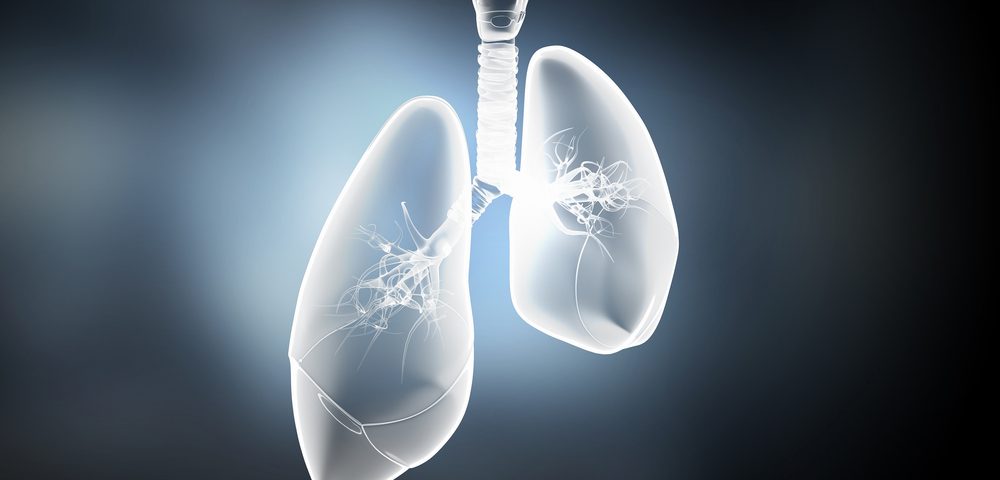Protein that Drives Cancer Is Potential New Therapeutic Target for Idiopathic Pulmonary Fibrosis, Study Suggests

High levels of PD-L1 protein were found in the most aggressive fibroblasts that drive idiopathic pulmonary fibrosis (IPF) progression, making the protein — whose levels are increased in cancer cells to shield a tumor from the immune system — a potential new therapeutic target, a study suggests.
The study, “PD-L1 on invasive fibroblasts drives fibrosis in a humanized model of idiopathic pulmonary fibrosis,” was published in the journal JCI Insight.
Lung fibrosis (scarring) is associated with a high mortality rate. The abnormal scarring of lung tissue damages healthy tissue and compromises the respiratory gas exchanges, ultimately leading to respiratory dysfunction and failure.
“At present, there is no known cure for this devastating condition,” Paul Noble, MD, professor of medicine, director of the Women’s Guild Lung Institute at Cedars-Sinai, and the study’s lead author, said in a press release.
“Current FDA-approved drugs only slow the fibrosis in certain individuals or treat some symptoms. This study opens a pathway for developing a treatment for idiopathic pulmonary fibrosis,” Noble added.
The cells responsible for excessive scar formation are called fibroblasts, and scientists believe that IPF fibroblasts behave differently compared with healthy ones. In previous studies, researchers demonstrated that in IPF, fibroblasts become invasive and can penetrate normal lung tissue and form scar tissue that progressively impairs lung function.
The Pulmonary Fibrosis News forums are a place to connect with other patients, share tips and talk about the latest research. Check them out today!
The researchers at Cedars-Sinai looked at the genetic profile of invasive versus non-invasive fibroblasts to understand the differences in their behavior. They compared the levels of gene activity between the two sets of fibroblasts, and observed that in invasive fibroblasts, the activity of 719 genes was increased (upregulated), and 686 genes were downregulated (lower activity), compared with non-invasive fibroblasts.
Among the upregulated genes, they found PD-L1 (also known as CD274) and PD-L2 — both binding partners of the programmed cell death protein 1 (PD-1).
PD-L1 is a surface protein that binds to its receptor PD-1, usually present on immune cells, preventing immune cells from attacking cells of the body. Cancer cells are known to increase PD-L1 expression to avoid being killed by immune cells. Targeting PD-L1 and PD-1 with antibodies that block their interaction is showing great promise and clinical benefits for many cancers.
In the study, researchers removed the PD-L1 gene from fibroblasts, and demonstrated that deleting this gene blocked cell migration and invasion, whereas activating this gene lead to migration and invasion by IPF fibroblasts.
To understand if PD-L1 was responsible for a more aggressive fibroblast type, the researchers tested if mice receiving the two kinds of fibroblasts had differences in lung fibrosis. They found that mice with highly expressing PD-L1 fibroblasts developed significantly more lung fibrosis than mice that received PD-L1 negative fibroblasts.
Further experiments showed that PD-L1 activity in invasive fibroblasts was regulated by two proteins called p53 and FAK. In mice injected with PD-L1 positive fibroblasts, inhibiting FAK with a small molecule inhibitor called VS4718 prevented the development of lung fibrosis.
Moreover, treating mice with an antibody against PD-L1 decreased fibrosis development at early (days 0–35) and late stages (days 35–63) of the fibrotic process.
“Cumulatively, these results identify PD-L1 as a driver of fibroblast invasion in idiopathic pulmonary fibrosis, and support PD-L1 as a potential therapeutic target for the condition,” said Dianhua Jiang, MD, PhD, the study’s co-lead author.
The researchers are now designing a proposal for a Phase 1 trial to test the safety and efficacy of PD-L1 inhibitors in IPF patients.
The U.S. Food and Drug Admnistration has approved several PD-L1 inhibitors as a treatment for cancer.
“Our proposal is to use one of these FDA-approved drugs in a clinical trial for idiopathic pulmonary fibrosis,” Noble said.






